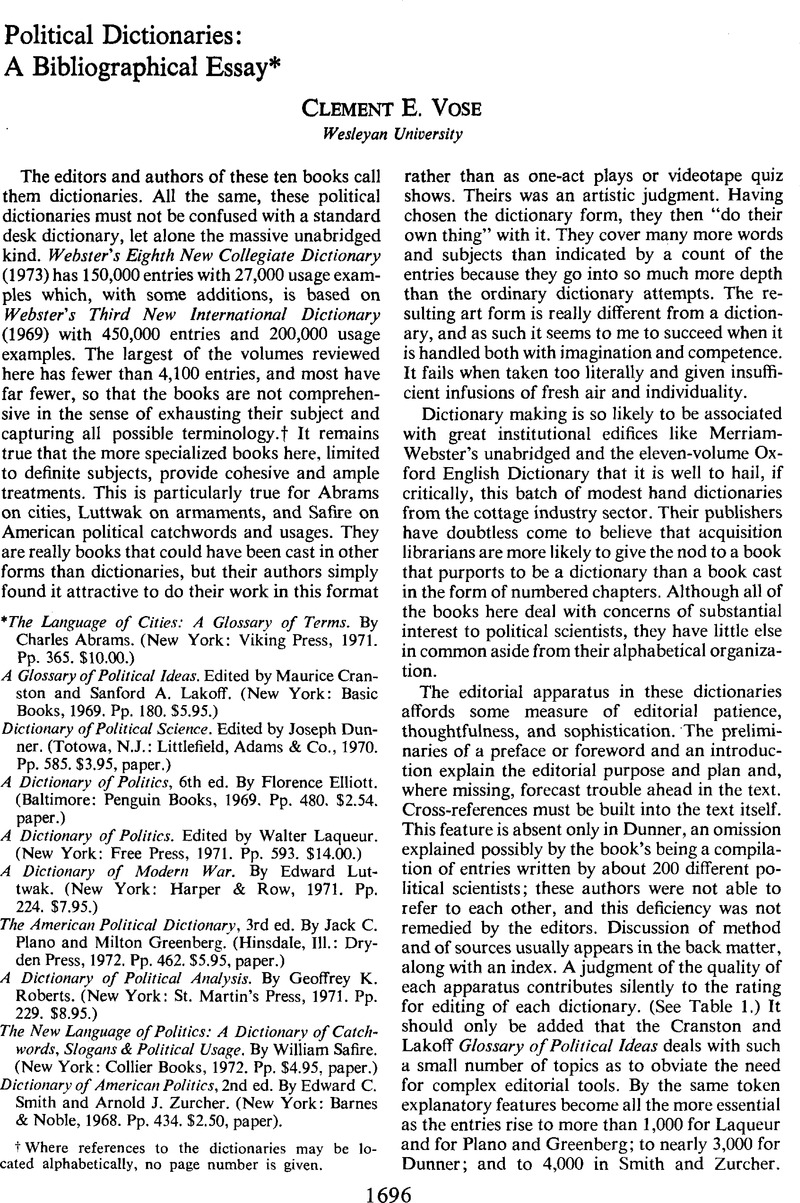Article contents
Political Dictionaries: A Bibliographical Essay*
Published online by Cambridge University Press: 02 September 2013
Abstract

- Type
- Book Reviews and Essays
- Information
- Copyright
- Copyright © American Political Science Association 1974
References
† Where references to the dictionaries may be located alphabetically, no page number is given.
1 After the present essay was completed, the U. N. Special Committee on the Question of Defining Aggression agreed upon a draft definition of the word, submitting it for adoption by the General Assembly at its September, 1974 session. The draft is divided into eight articles containing seventeen paragraphs, too lengthy for quotation here. Article 1 begins: “Aggression is the use of armed force by a state against the sovereignty, territorial integrity or political independence of another state or in any other manner inconsistent with the Charter of the United Nations, as set out in this definition” (New York Times, April 13, 1974, p. 6Google Scholar). Details on the history of the Special Committee may be found in numerous official publications such as Yearbook of the United Nations 1971, v. 25 (United Nations, N. Y.: Office of Public Information, United Nations, 1974), pp. 597–601Google Scholar.
2 Corwin, Edward S., The President: Office and Powers, 1787–1957, 4th ed. (New York: New York University Press, 1957), p. 39Google Scholar.
3 Schattschneider, E. E., Two Hundred Million Americans in Search of a Government (New York: Holt, Rinehart and Winston, 1969), p. 14Google Scholar.
4 Sorauf, Frank J., Party Politics in America, 2d ed. (Boston: Little, Brown and Company, 1972), p. 110Google Scholar.
5 Speaking of the active, revivalist phase of mass movements, Hoffer states that this phase is dominated by the “true believer” defined as “the man of fanatical faith who is ready to sacrifice his life for a holy cause.” Hoffer, Eric, The True Believer: Thoughts on the Nature of Mass Movements (New York: Harper and Brothers, 1951), p. 10Google Scholar.
6 The “friends and neighbors effect” is Key's phrase for a powerful localism in Alabama factionalism where “candidates for state office tend to poll overwhelming majorities in their home counties and to draw heavy support in adjacent counties.” Key believes this “points to the absence of stable, well-organized, state-wide factions of like-minded citizens formed to advocate measures of common concern.” Key, V. O., Southern Politics in State and Nation (New York: Alfred A. Knopf, 1949), p. 37Google Scholar.
7 The idea of employing the word “democracy” to connote the ideal and “polyarchy” the real, the latter to serve as a measure of achieving the former appears first in Dahl, Robert A. and Lindblom, Charles E., Politics, Economics, and Welfare: Planning and Politico-Economic Systems Resolved into Basic Social Processes (New York: Harper & Row, 1953), pp. 272–323Google Scholar. Dahl has reintroduced “polyarchy” instead of the word “pluralism” in the latest edition of his text, Dahl, Robert A., Democracy in the United States: Promise and Performance, 2d ed. (Chicago: Rand McNally and Company, 1972), p. viiGoogle Scholar.
8 Sorauf, p. 8.
9 Rawls, John, A Theory of Justice (Cambridge, Mass.: The Belknap Press of Harvard University Press, 1971), p. 269Google Scholar.
10 Muir, William K. Jr.,, Prayer in the Public Schools: Law and Attitude Change (Chicago: University of Chicago Press, 1967), p. 4Google Scholar. Muir has thus brought to the attention of political scientists and lawyers a term propounded by Festinger, Leon in A Theory of Cognitive Dissonance (Evanston, Ill.: Row, Peterson, 1957)Google Scholar.
11 Fellman, David, “Federalism,” American Political Science Review, 41 (December, 1947), 1142CrossRefGoogle Scholar.
12 Fed. Rules Civ. Proc., 23 (1966). See 26 U.S.C.A. for annotations.
13 Skidmore, Max J., ed., Word Politics: Essays on Language and Politics (Palo Alto: James E. Freel & Associates, Inc., 1972), p. 7Google Scholar.
- 1
- Cited by





Comments
No Comments have been published for this article.